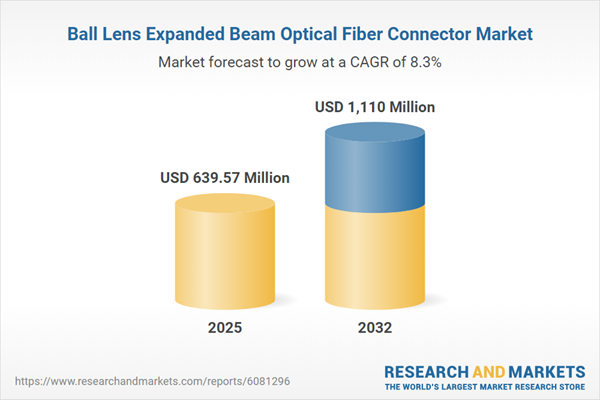Speak directly to the analyst to clarify any post sales queries you may have.
The Ball Lens Expanded Beam Optical Fiber Connector market is evolving as organizations demand high-performance, resilient connectivity across critical networks. Advances in interconnect technology and shifting global policies are prompting industry leaders to revisit their optical infrastructure strategies for greater reliability and cost efficiency.
Market Snapshot: Ball Lens Expanded Beam Optical Fiber Connector Market
The Ball Lens Expanded Beam Optical Fiber Connector Market grew from USD 592.69 million in 2024 to USD 639.57 million in 2025. It is expected to continue growing at a CAGR of 8.26%, reaching USD 1.11 billion by 2032. Senior decision-makers in telecommunications, industrial automation, defense, and data communications are recognizing the value of expanded beam connectivity for enabling robust performance in challenging environments and supporting emerging digital applications.
Scope & Segmentation
This market report covers a comprehensive range of segments, applications, and technologies to deliver in-depth insights geared toward strategic planning:
- Transmission Modes: Multi Mode; Single Mode.
- Connector Interfaces: Ferrule Connector (FC); Lucent Connector (LC); MTP/MPO; Square Connector (SC); Straight Tip (ST).
- Applications: Data Communications; Industrial Automation; Medical; Military; Telecommunication.
- Sales Channels: Offline; Online (Company Websites; E-Commerce Platforms).
- Regional Coverage: Americas (North America: United States, Canada, Mexico; Latin America: Brazil, Argentina, Chile, Colombia, Peru); Europe, Middle East, and Africa (Europe: United Kingdom, Germany, France, Russia, Italy, Spain, Netherlands, Sweden, Poland, Switzerland; Middle East: United Arab Emirates, Saudi Arabia, Qatar, Turkey, Israel; Africa: South Africa, Nigeria, Egypt, Kenya); Asia-Pacific (China, India, Japan, Australia, South Korea, Indonesia, Thailand, Malaysia, Singapore, Taiwan).
- Key Companies Analyzed: Amphenol Corporation; FC Lane Electronics Ltd.; Fibicon; Foss Fibre Optics s.r.o; Glenair, Inc; HARTING Technology Group; HUBER+SUHNER AG; kSARIA Corporation; Micropol Fiberoptic AB; Molex LLC by Koch Inc.; Neutrik AG; ODU GmbH & Co. KG; Optical Fiber Packaging Ltd; Radiall SA; TE Connectivity Ltd.
Key Takeaways for Senior Decision-Makers
- Ball lens expanded beam optical fiber connectors deliver consistent signal integrity where vibration, temperature shifts, and environmental contaminants challenge traditional connectors.
- Expanded beam architecture reduces cleaning frequency and potential connector damage, resulting in lower lifecycle costs and improved network uptime across critical applications.
- Rapid mating cycles and minimal insertion loss are valuable advantages in mission-critical deployments such as telecommunications core infrastructure, medical imaging, and defense systems.
- Developments in micro-optics manufacturing and AI-powered alignment systems are pushing performance metrics higher, making advanced expanded beam solutions increasingly accessible.
- Standards updates and global regulatory changes, especially in Europe, the Middle East, and Asia-Pacific, are accelerating the adoption of expanded beam technology and facilitating cross-border interoperability.
- Emergence of predictive monitoring through smart sensor integration is creating opportunities for proactive maintenance in modern optical networks.
Tariff Impact on Supply Chain & Pricing Dynamics
The revised United States tariffs introduced in 2025 have prompted manufacturers and suppliers to refine sourcing and production strategies. Companies are diversifying supply chains, shifting critical optical component manufacturing to more favorable regions, renegotiating contracts, and forming tighter relationships with logistics providers. These adaptations have improved resilience, minimized cost pressures, and positioned proactive organizations to better respond to global trade uncertainties.
Methodology & Data Sources
This report applies a rigorous research approach by combining comprehensive secondary research from standards bodies, technical documents, and patent filings with primary interviews of industry leaders and key stakeholders. Structured surveys and validation workshops enhance the reliability of findings and ensure actionable insights for real-world decision-making.
Why This Report Matters
- Enables informed procurement, technology roadmap, and partnership decisions for organizations navigating the rapidly evolving optical connectivity landscape.
- Provides granular intelligence on emerging trends, regional opportunities, and the impact of regulatory developments on the Ball Lens Expanded Beam Optical Fiber Connector market.
- Supports strategic planning by highlighting investment areas that align with future network scalability, resilience, and sustainability goals.
Conclusion
The shift toward ball lens expanded beam connectors is redefining standards for robust and future-ready optical networks. Strategic adaptation to advancements in manufacturing, regulatory developments, and supply chain design will help organizations secure a competitive edge as connectivity needs evolve.
Table of Contents
3. Executive Summary
4. Market Overview
7. Cumulative Impact of Artificial Intelligence 2025
Companies Mentioned
The companies profiled in this Ball Lens Expanded Beam Optical Fiber Connector Market report include:- Amphenol Corporation
- FC Lane Electronics Ltd.
- Fibicon
- Foss Fibre Optics s.r.o
- Glenair, Inc
- HARTING Technology Group
- HUBER+SUHNER AG
- kSARIA Corporation
- Micropol Fiberoptic AB,
- Molex LLC by Koch Inc.
- Neutrik AG
- ODU GmbH & Co. KG
- Optical Fiber Packaging Ltd
- Radiall SA
- TE Connectivity Ltd.
Table Information
| Report Attribute | Details |
|---|---|
| No. of Pages | 189 |
| Published | November 2025 |
| Forecast Period | 2025 - 2032 |
| Estimated Market Value ( USD | $ 639.57 Million |
| Forecasted Market Value ( USD | $ 1110 Million |
| Compound Annual Growth Rate | 8.2% |
| Regions Covered | Global |
| No. of Companies Mentioned | 15 |









